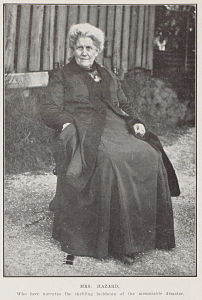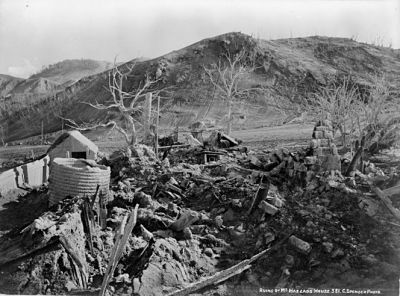Purewa – Amelia and Charles Haszard
Amelia Jane Haszard was born on Prince Edward Island, Canada in 1843 and came to New Zealand in 1859 with her parents.
In 1863 she married her second cousin Charles Albert Haszard, who was at one time a compositor on the Southern Cross newspaper, and afterwards was a farmer and storekeeper, at Bombay. In 1886 Charles Haszard was teacher of a Maori school at the time the village of Wairoa was buried as a result of the eruption of Mount Tarawera. Surveyor John Blythe and his assistant Harry Lundius were staying with the Haszards at Te Wairoa after road-surveying in the Urewera country. After celebrating Amelia’s birthday on 10 June 1886, all had gone to bed, when they were woken by violent earthquakes and huge explosions.
At about 3am stones came thundering down on the top of the house and the roof began to collapse. Blythe and Lundius helped the family in the dark and got out of the house with Charles’s daughter Clara, taking refuge in a neighbouring fowl house. [2]
Charles observed the eruption from his verandah and was said to have exclaimed, ‘What a grand sight! Should we live a hundred years we shall never again see its equal.’ He died a few hours later when his house collapsed. [3]
Charles Haszard and three of their children, Charles age 10, Edna age 6, and Mona, age 4, lost their lives on that awful night. Amelia Haszard and two daughters, Clara, age 22 and Ina, age 16, managed to escape. The volcanic material from Tarawera buried the village, and the roof of the Haszard’s house fell in, pinning Amelia Haszard by her arm. Clara and Ina managed to get out of a window and took refuge in a neighbours fowl house. Amelia Haszard sat in the ruined house all night, but was rescued the next day. [4] Her brother William’s son Charles Sutherland Haszard also died in the eruption, aged 10 years old. [5]
Amelia later described her “night of horror” – “My two daughters escaped into a detached portion of the house.” she said. “While sitting in my chair with my three remaining children around me, I was pinned to the, floor by the roof falling in and I believe that it was at that time my husband was killed. I had my youngest child, a girl aged four in my arms, a boy aged ten on my right and a girl of six on my left. The, child in my arms called for me to give her more room as T was pressing her against a beam, but the load of volcanic mud pouring down on me prevented me from being able to render any assistance, and the child was crushed and smothered in my arms and died. The, boy said, ‘ Mamma, I will die with you,’ and I think he died shortly after, as he did not answer again. The little girl, I think, died shortly after, as she said, ‘ Oh, my head,’ as the mud was beating down on her, and she spoke no more. I was rescued after being entombed for several hours.” [6]
About 120 people died in the six-hour eruption and the village of Te Wairoa was buried. It later became known as ‘The Buried Village’, a major tourist attraction.
Amelia died on 6 September 1925 and was survived by her daughter, Mrs. Ina Hobbs, of Papakura, her daughter Clara having died aged 36 in 1900 from influenza. She was also survived by two brothers. Messrs. A. J. (Alexander James) Haszard of Hamilton, and S. F. (Sydney Fade) Haszard, of Empire Road, formerly of the Postal Department, also a sister Sarah, Mrs. G. W. (George William) Murray. The wife of Sir James Parr, Marie Elizabeth (Betty) Seifert was a niece of Amelia, and another niece was Alice, Mrs. Watson Airey, of Remuera. Amelia was buried at Purewa Cemetery, Block A, Row 15, Plot 12C. [7]





